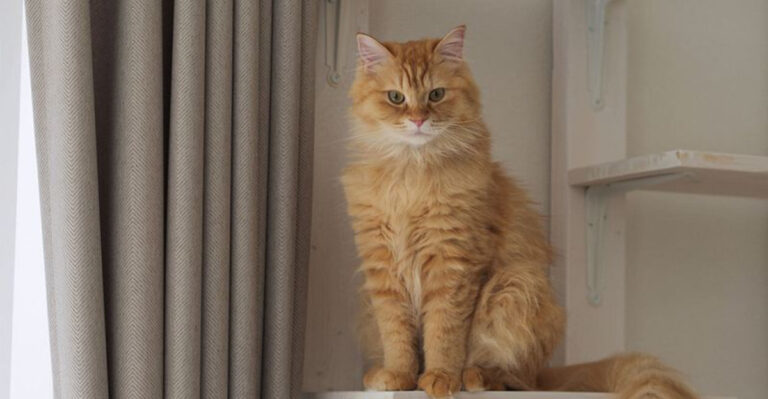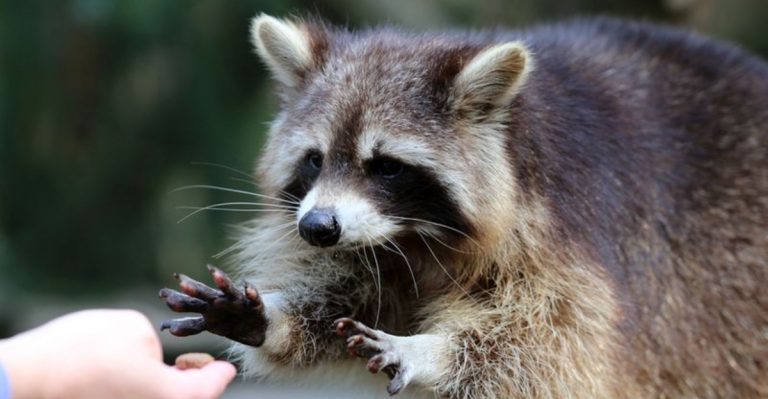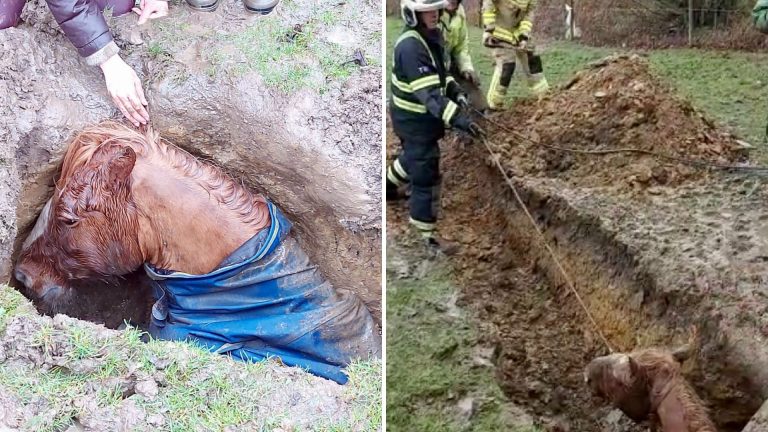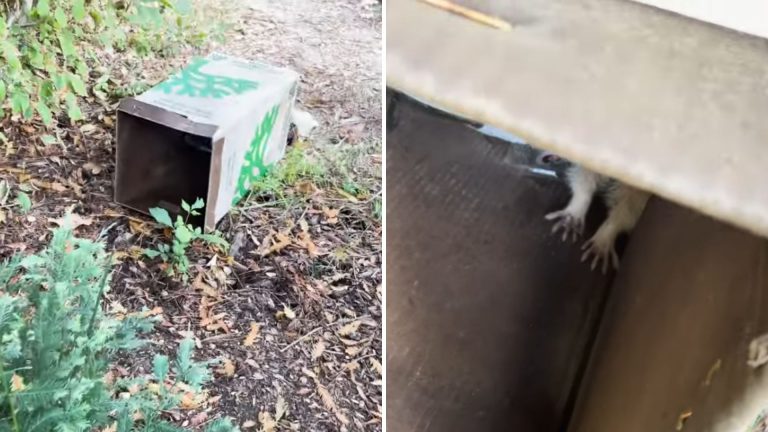Does Cat Hair Grow Back? When It Does & When It Doesn’t
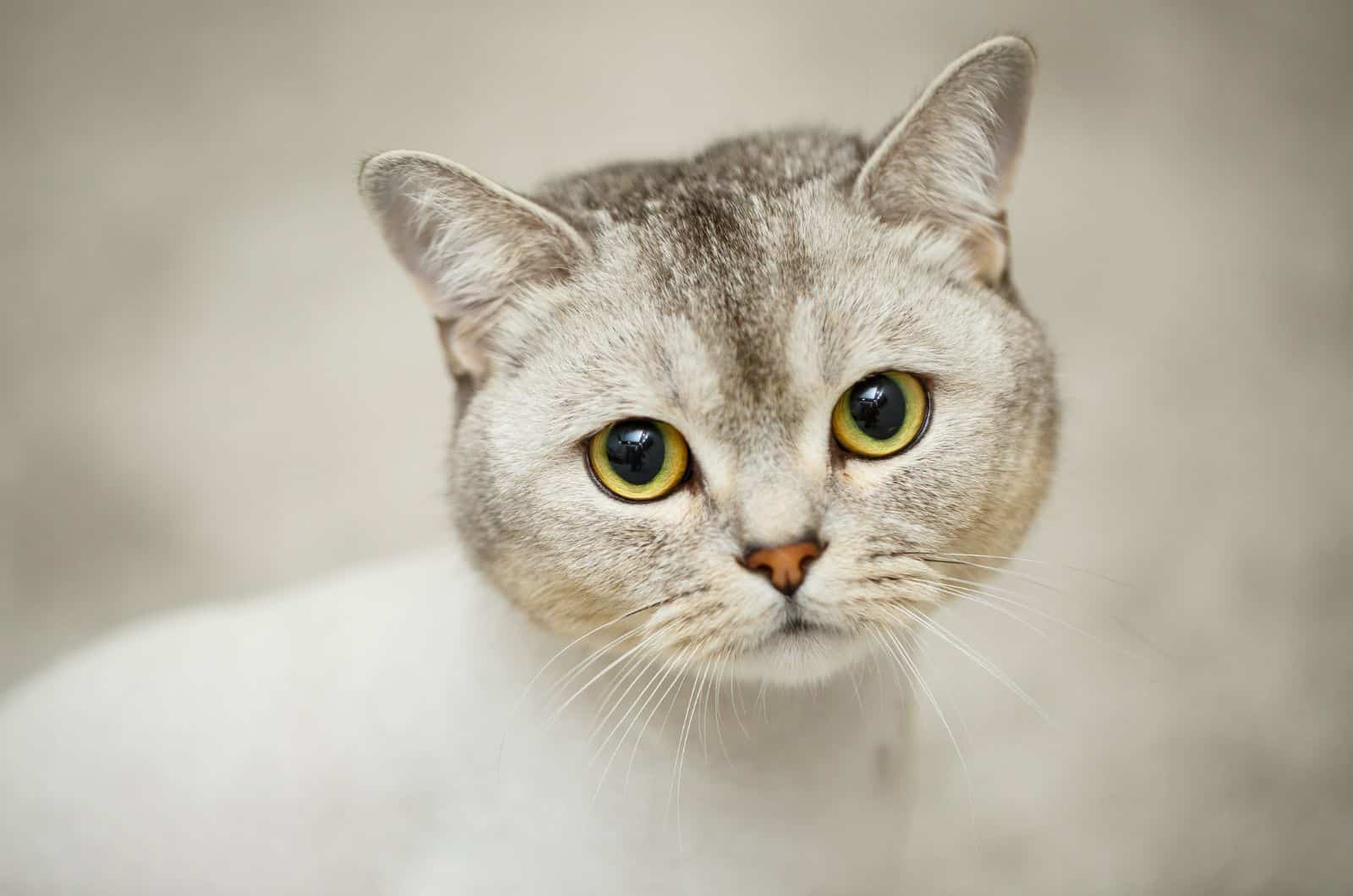
Did you completely shave your cat or give them the famous lion cut? Perhaps your cat has had surgery and they have a shaved patch around the surgical site? Or have you noticed that your cat has started losing hair for no obvious reason and you’re slightly worried?
If the answer is Yes to any of these questions, you’re surely wondering: Does cat hair grow back? And if yes, when?
Whether the cat’s hair will grow back or not depends on the cause of the hair loss(was it a hair clipper, or disease?). However,most of the time, cat hair does grow back! It may take up to 3 months for short-haired cat breeds and up to 6 months for long-haired cat breeds, but the hair will usually return.
Whether or not the hair will grow back depends on the cause of the hair loss. If your cat’s hair has simply been cut, for whatever reason, it will surely grow back. However, if the underlying cause of hair loss is an allergy, an infection or a disease, then there are some rare instances when a cat’s hair will not grow back.
Continue reading to learn about the potential causes of hair loss and whether you can expect your cat’s hair to grow back!
Does Cat Hair Grow Back?
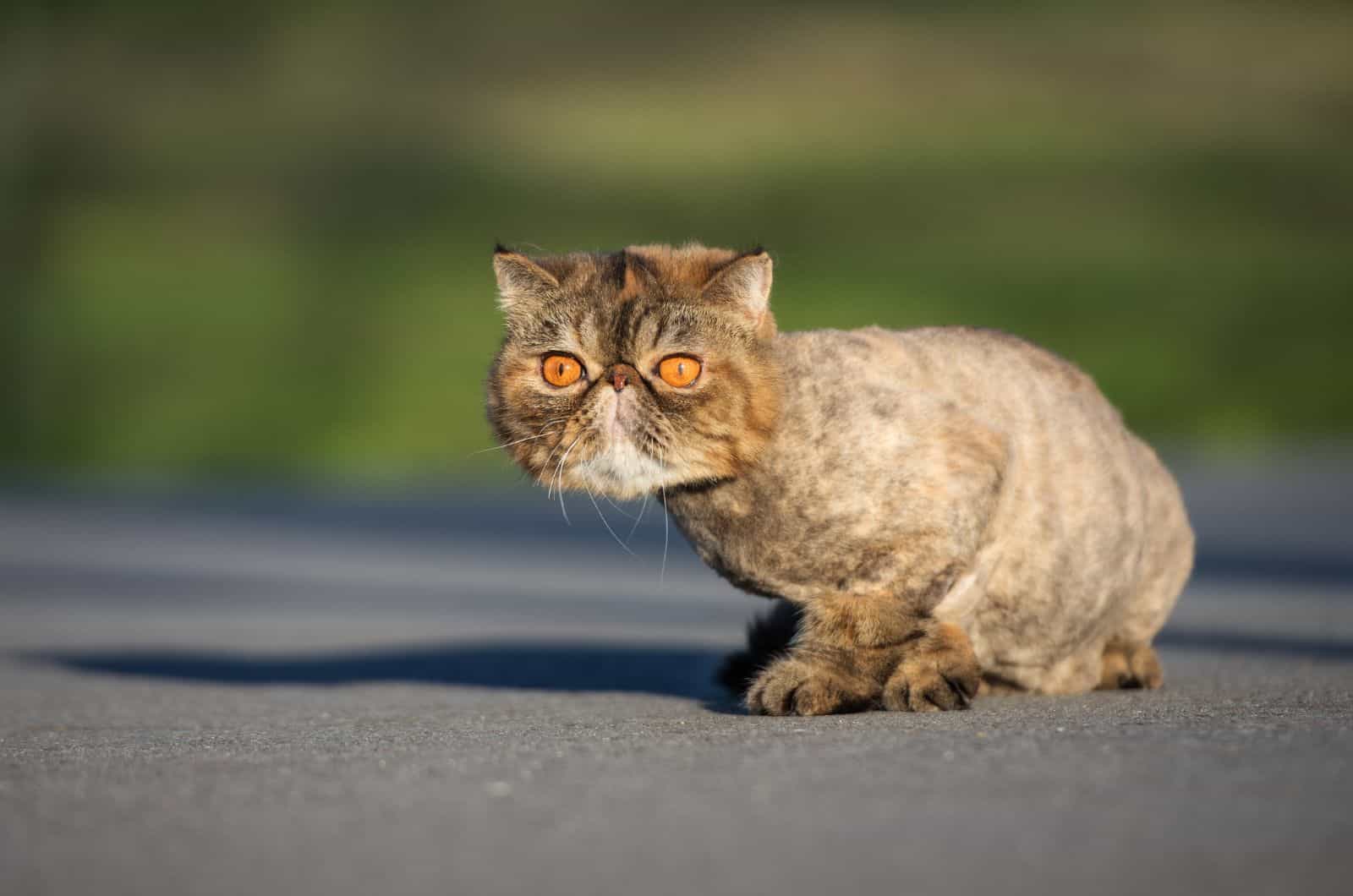
I’m sure this is one of the main questions asked by cat owners whose pets have lost their coats. It’s understandable to wonder if the hair will start coming back soon, and the answer is usually YES! In most cases, the hair will probably grow back with the right care, providing the cause of your cat’s hair loss is dealt with and is not genetic!
The key to hair regrowth is addressing the infection or condition that caused the problem as soon as possible and using the proper medication or treatment. Unless it is the result of a haircut, in which case, you just have to wait!
You shouldn’t take cat hair loss on the ears or other body parts lightly, as some of the infections and diseases that cause hair loss can also cause many other – more dangerous – symptoms.
Until the underlying reason for hair loss is addressed, the hair won’t grow back. Your pet’s fur will begin to regrow faster and more effectively the sooner you start treating the problem!
However, usually cat hair takes between one and six months to regrow properly.
How Fast Does Cat Hair Grow?
There are no firm rules about how fast a cat’s hair grows. It will vary between breeds and individual cats. However, there are general time ranges when we can expect a cat’s hair to fully grow back.
For long-haired cats, the time it takes for the hair to reach its full length ranges from 4 to 6 months.
For short-haired cats, you can anticipate your cat’s hair to regrow from a matter of weeks to 3 months.
14 Causes Of Hair Loss In Cats & Will The Cat’s Hair Grow Back?
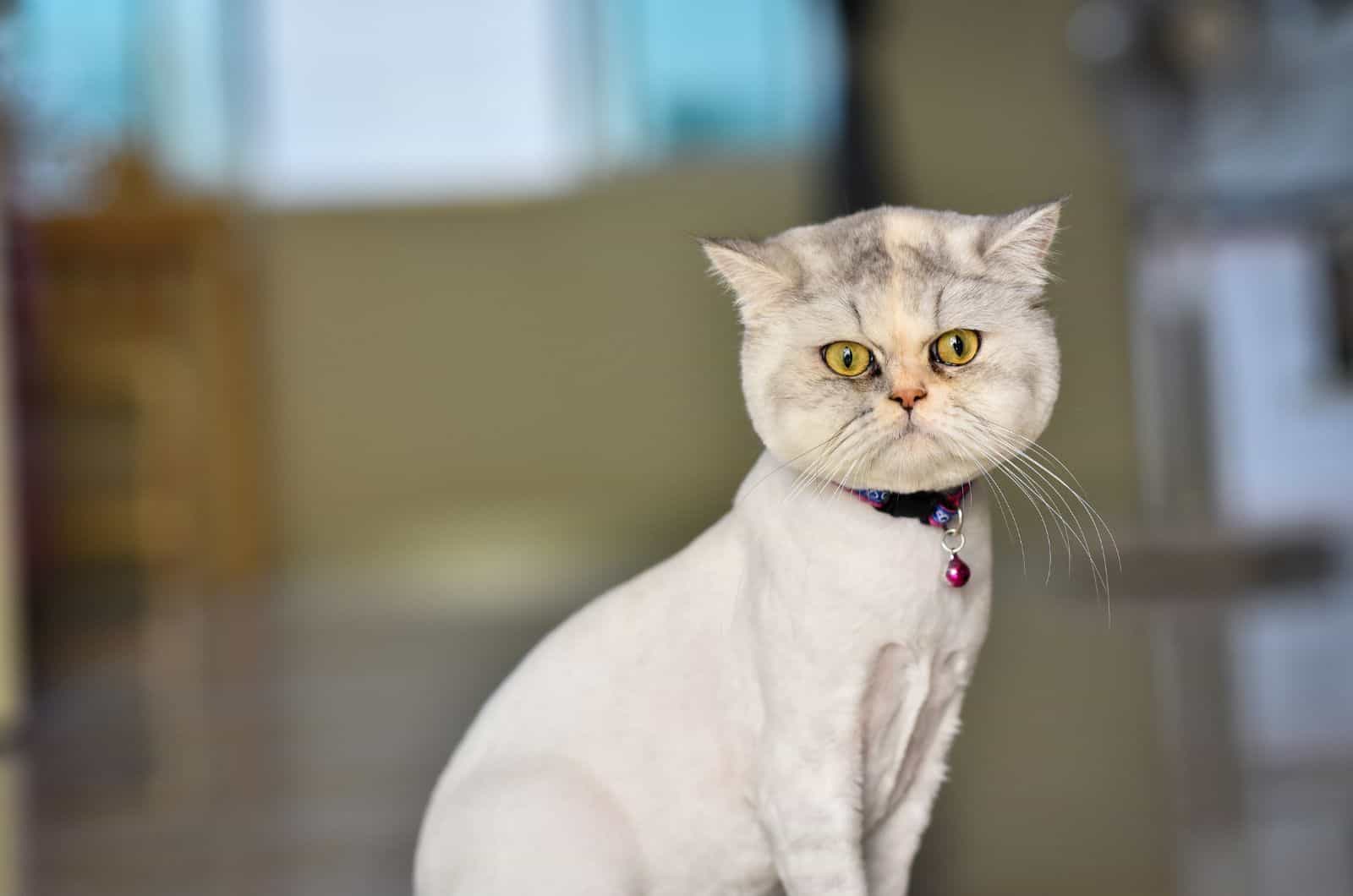
Whether the cat’s hair will grow back depends primarily on the cause of hair loss, so let’s investigate!
1. The Owner Decided To Get Their Cat’s Fur Shaved
There are several reasons why a cat’s fur will be shaved completely or at one site, including:
• A cat’s fur becoming matted
If a cat’s fur is tangled beyond help, a groomer may advise that shaving it off is the only option. Proper care needs to be taken to ensure that the new fur doesn’t get tangled as well.
• An older cat not being able to groom themselves anymore
Older cats might not be so eager (or not agile enough) to groom themselves anymore and that can lead to shedding problems, leading cat owners to remove fur.
• In order to prevent hairball issues
Hairballs are a potential issue, and if your cat is prone to hairball formation due to ingesting their own hair, shaving them could resolve the issue.
• Giving a cat the famous lion cut haircut
Although cat owners should not give their long-haired cats this haircut simply because they think it “looks cute”, some still decide to do it.
If the cause of your cat’s hair loss is shaving, you can expect the cat’s coat to regrow anywhere from 2-3 months for short haired cats, and 3-6 months for long haired cats.
2. Surgical Procedure Required Localized Shaving
Localized shaving of the cat’s fur is done by a veterinarian prior to a surgical procedure. This ensures the surgical site is clean and easy to access.
For example, shaving a small area of the cat’s body is necessary for the neutering or spaying procedure to be carried out.
Do not worry – the cat’s hair will grow back!
You may be wondering, How long does it take for cat hair to grow back after surgery? The answer is simple – up to 3 months for a shorthaired car and up to 6 months for longhaired cats.
If the surgical incision leads to scarring, there is a chance that the cat’s hair will not grow back fully.
3. Natural Fur Shedding
At specific times of the year, cats will shed their fur. This is a natural process that keeps them cool throughout the hotter months. As the seasons begin to change again, the hair should grow back.
There is a basic timeline for when the hair should regrow after a cat molts. The molting season typically lasts from spring to summer, and it is more pronounced in cats who have access to the outdoors. This is because indoor cats live in climate-controlled environments. It typically takes 2-3 weeks for the hair to regrow into a winter coat once they have shed.
Although the cat’s hair will not fall out completely, it will be considerably thinner. Most of the time, only the undercoat is lost.
If your cat’s hair isn’t growing but it’s summer, there may be no need for concern. Once the weather begins to cool again, it should regrow. Remember that molting happens very evenly all over the body. It is more likely that there is another cause if hair is only falling out in specific areas.
4. Fungal Infection
Yeasts, molds, and mushrooms are among the microorganisms that make up the fungus group. Intense itching brought on by fungal infections can result in scabs, blisters, lesions, and eventually hair loss.
Treating the fungal infection is key to stopping the hair loss; treat it effectively and the hair should return. Consult your vet for specific information about hair regrowth when your pet is diagnosed with a fungal infection.
a) Ringworm
Cat lovers, don’t be alarmed – there are definitely no worms present in this condition. It really is a misleading name for a fungal skin illness!
The rash caused by this fungal infection resembles a ring on the skin, so the infection is known as a ringworm. The face, tail, feet, and ears are most frequently affected (ear tips, to be more precise) and these places will eventually develop bald spots.
It is important to take this infection seriously. Even though it’s a serious condition, it is totally treatable.
If the vet suspects a ringworm infection, skin scrapings are taken to the lab to confirm the presence of this type of fungal infection.
Don’t worry – when the infection is resolved, the cat’s fur will grow back fully.
b) Yeast
Although it is extremely unlikely, pet cats can develop a yeast infection. The most common symptom of a yeast infection is a localized loss of hair, the development of skin lesions, and scaly skin.
Topical ointments prescribed by the vet will solve this problem, and after successful treatment, the cat’s hair will grow back.
5. Mite Infection
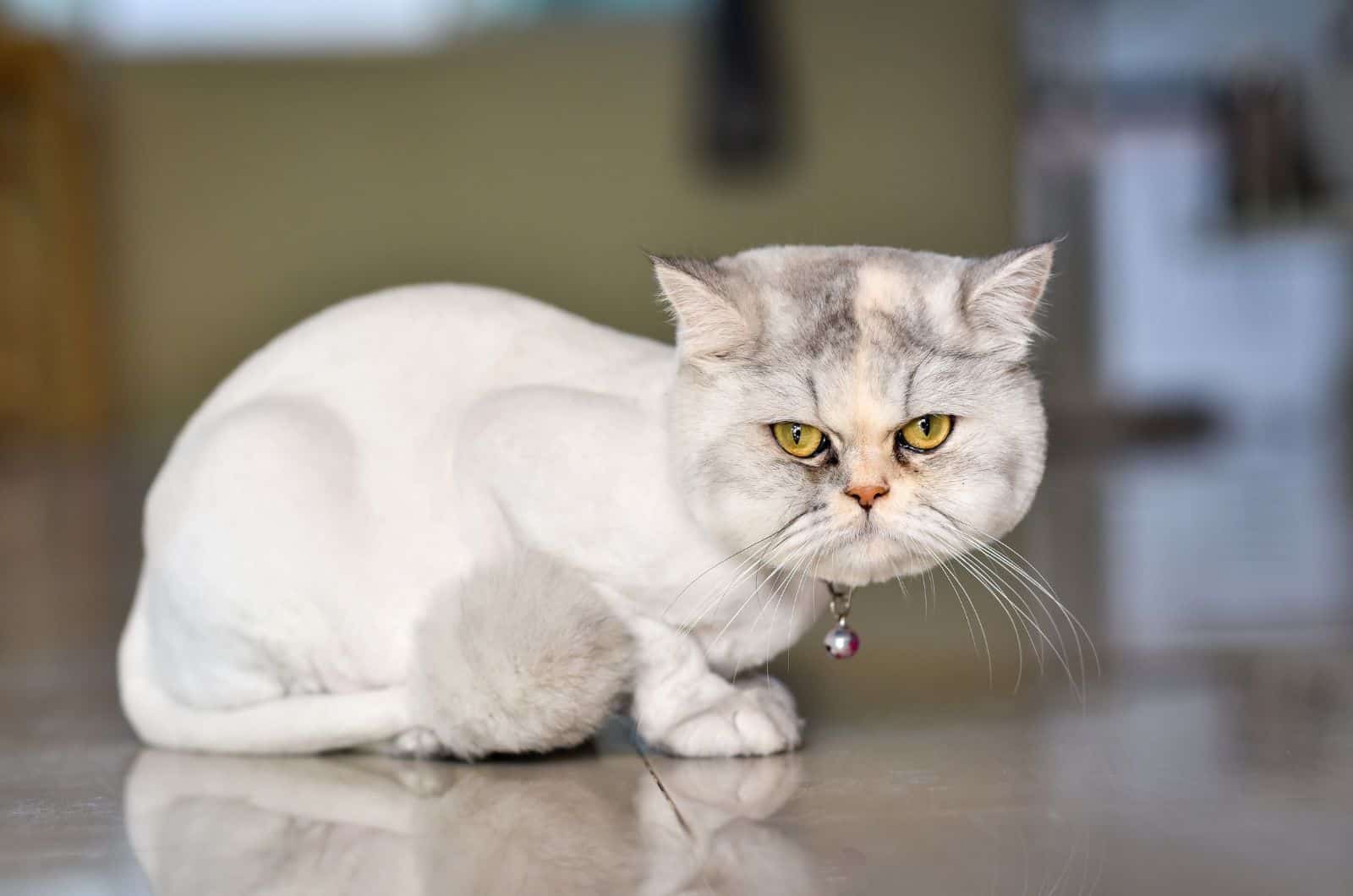
Mites are parasites that usually infect a cat’s ear(s). They are hard to see with the naked eye and they cause a lot of itching (and scratching) for the afflicted cat.
Feline mange (or scabies) is a very contagious but rare mite infection. It results in extreme scratching and hair loss in the affected area.
Ticks are also mites, and they are easily picked up by a cat from outdoors. They typically attach themselves close to the head, neck, and ear region.
Your pet shaking its head, rubbing it against objects, and scratching at the ears are all symptoms of a tick infestation.
Again, there is no need to worry – after successful treatment, the cat’s fur will grow back fully!
6. Fleas
Fleas are parasites that love to make a cat their host. When you use a flea comb to comb your cat, you might be able to see them.
The most obvious indicator that your cat has fleas is that it scratches all the time. Intense scratching often leads to hair loss.
A flea collar and a topical flea treatment are the most successful treatment options and you can expect your cat’s hair to regrow fully after you get rid of all parasites.
7. Poor Diet
A healthy diet is crucial for a cat to have healthy fur. Lack of essential nutrients can result in brittle fur and even hair loss. For healthy skin and hair, sufficient amounts of high-quality, digestible protein and the vitamins A, B and E are required.
Owners who prepare their own cat’s food must take extra care to provide their cats with a proper nutritionally-balanced diet.
8. Hormonal Imbalance
Hyperthyroidism is a condition characterized by the overproduction of thyroid hormone by the thyroid glands. Older cats are especially prone to problems with the thyroid.
A cat with hyperthyroidism may display the following symptoms:
• Patchy hair loss
• Weight loss
• Restlessness
• Increased thirst/water intake
• Vomiting and diarrhea
This medical issue is treatable and most cats respond well to ongoing treatment. You can expect your cat’s hair to grow back fully when the treatment is successful.
9. Stress
Numerous health issues in felines are brought on by stress. One sign that a cat is experiencing a lot of stress is compulsive scratching or even habitual biting of the same spots over and over. It can be hard to tell if the cat is scratching due to a skin condition or due to stress or anxiety.
Frequent scratching can lead to localized hair loss and the formation of scabs. These can even become infected.
The key to successful treatment is finding the exact cause of stress and managing it. If the stress can be managed or eliminated, you can expect your cat’s bald patches to start growing hair as soon as the scratching stops.
10. Hereditary Feline Alopecia

A lack of hair in areas where hair should be present is known as cat alopecia. Occasionally, a cat’s hair will fall out naturally and not as a result of your cat’s behavior.
If hair loss or baldness is genetic (i.e. inherited in the genes), the hair follicles either cease growing or do not grow properly, resulting in localized baldness.
Hereditary hair loss is more common in certain cat breeds than others. Due to their genetic makeup, some pure breeds are more prone to alopecia, including:
• Burmese cat breed
• Birman cat breed
• Bengal cat breed
• Devon Rex cat breed
• Himalayan cat breed
• Siamese cat breed
Hereditary alopecia, fortunately, doesn’t bother cats and does not cause itching or other symptoms.
In this scenario, hair loss is not a result of anything you or your cat are doing; your cat’s genes are to blame. Unfortunately, it also means that you are helpless to stop it from happening.
If your cat has been diagnosed with this condition, don’t try to fix it using creams, medication, changing shampoos, etc, because it will not work.
11. Food Allergies
If a cat is allergic to a particular protein found in food, they may have a food allergy.
The most typical symptom is itching, which can affect any region of the body . Additionally, these cats frequently overgroom themselves, leading to sores and hair loss.
Finding the cause of your cat’s allergy is key to treating the symptoms and eliminating the allergy trigger from your cat’s life. After that, the hair will grow back.
12. Environmental Allergies
The allergens that your cat is most likely to breathe in are pollen, dust and mold, but other common allergies are the result of insect bites (such as flea saliva).
Your cat may experience watery eyes, wheezing, sneezing, and coughing, as well as scratching..
Scratching leads to localized hair loss that will only be resolved after solving the issue of food allergies for your cat.
13. Dermatitis
A skin ailment called dermatitis is characterized by skin irritation or inflammation. It causes severe itching, and scratching the itchy region causes your cat to develop scabs, lesions, and bald patches.
There are other symptoms of this disease, but the presence of visible bald patches is the most obvious one.
It is crucial that you take your cat to the vet because all of these skin issues are quite uncomfortable for your cat and none of them will go away on their own.
After successful treatment, you can expect your cat’s hair to grow back completely.
14. Skin Cancer
Our feline friends can also suffer from skin cancers, and these can manifest with a wide variety of symptoms. Some of these can be seen with the naked eye, while others can only be observed under a microscope or by performing diagnostic procedures.
As skin cancer is a potential cause of localized hair loss, it’s highly suggested to visit the vet if you observe your pet developing bald skin patches.
What Helps A Cat’s Hair Grow Back?
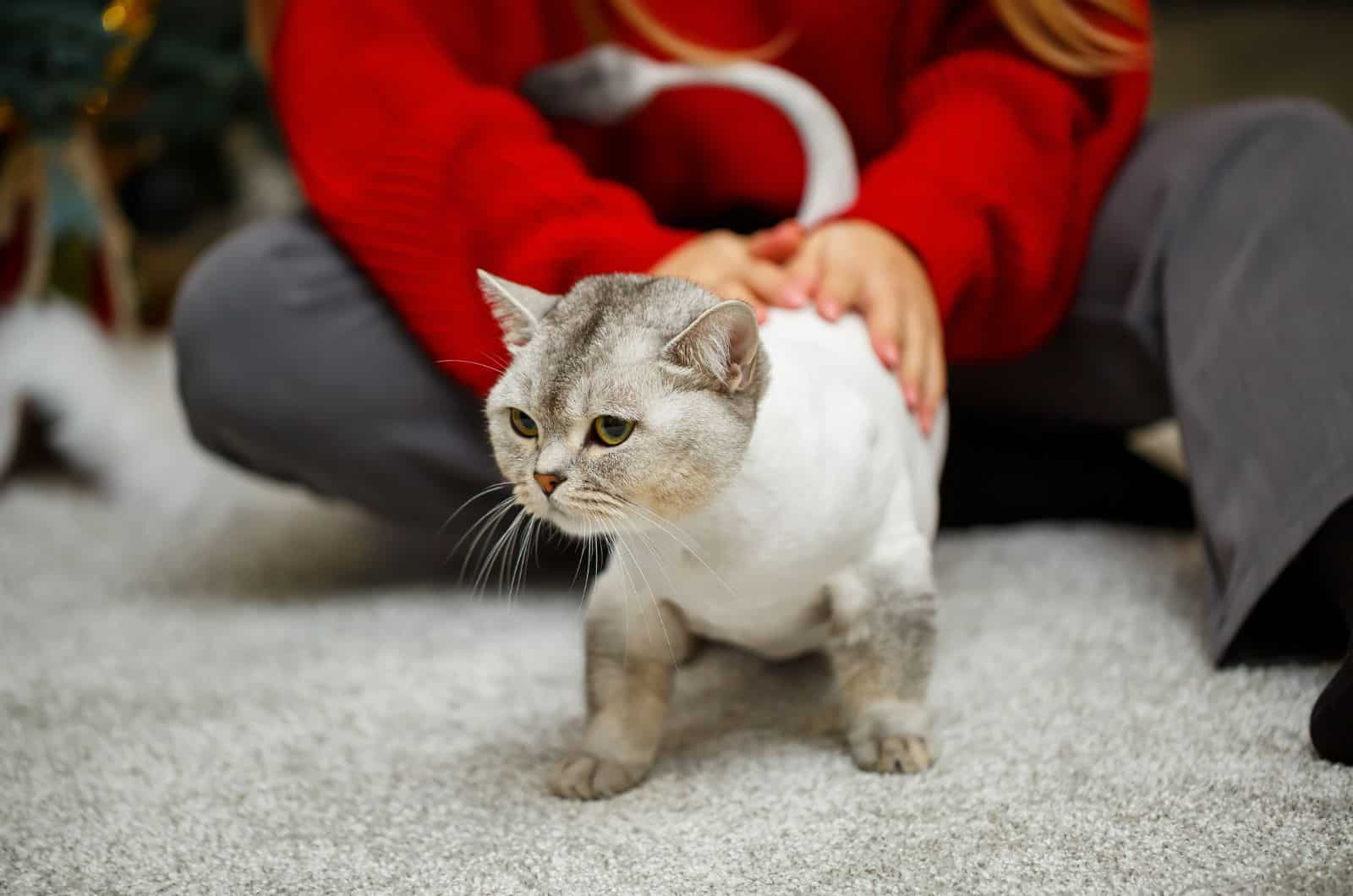
It may be a bit strange to see your cat without their fur. After all, having fur is actually necessary for the cat’s health, as it protects your cat from the outside world. It will come as no surprise then that many cat owners are interested in learning how to make their cat’s hair grow faster.
The most important thing for a cat’s hair growth is their diet!
Diet is the main factor in promoting healthy cat hair growth. We must therefore pay particular attention to providing our cat with the following nutrients:
• Lots of high-quality proteins
Proteins play a crucial role in the development and composition of your cat’s hair. Your cat may not be getting enough proteins, which could explain why its fur is growing very slowly. Although the quantity of food we give our cats matters, the quality is much more important.
• Correct quantities of vitamins
Vitamins are important for the health, strength, and beauty of both skin and hair. A lack of vitamins can cause alopecia, bald areas, and a weakened immune system. The most important vitamins for cat hair growth are vitamin A, vitamin C, vitamin E and the B complex vitamins.
• Proper levels of minerals
Many minerals are essential for a cat’s overall health, but zinc and copper are the ones which are most crucial for hair growth.
Using supplements is also highly recommended.
You can make sure your cat’s fur grows faster using dietary supplements. Supplements containing essential fatty acids Omega 3 and Omega 6 will also help the cat’s fur to be healthy and shiny. Always seek veterinary advice before using a supplement or changing your cat’s diet.
Apart from a healthy diet, it’s highly recommended that you provide your cat with an e-collar. This will stop your cat from licking and overgrooming the area where new hair is supposed to grow. It’s also good for making sure that any topical medication (such as ointment, lotion, or cream) is not licked off from the site of future hair regrowth.
Remember, there is no secret recipe for super-fast cat hair growth! These tips are only suggestions on how to promote hair growth and supply the best nutrients for a healthy coat.
How To Prevent Unintentional Hair Loss In Cats?

As hair loss is never a sign of good health, preventing hair loss in cats means preventing whatever injury, illness or behavior is causing the hair loss.
You can prevent unintentional hair loss by following these guidelines:
1. Proper And Regular Grooming
All cats will benefit from routine brushing to remove dead hair and encourage the growth of new hair. Some cats (such as long-haired cat breeds) will require more brushing than others.
2. Frequently Examine Your Cat’s Fur
If your cat spends a lot of time outside, you should take special note of this suggestion. Your cat may have acquired some unwanted guests in the yard, such as mites or fleas. Noticing them on time can prevent them from doing more harm to your pet.
3. Reducing Exposure To Stress
Controlling stress can help avoid many different health issues. Stress weakens the cat’s immune system, lowering its defenses and potentially resulting in hair loss.
4. Make Sure Your Cat Is Healthy
Even though I’m sure you’re paying attention to maintaining your cat’s health, it doesn’t hurt to go over the basics. Disease prevention is essential! Ensuring your cat is getting enough physical exercise, is eating a healthy diet and living in a healthy environment, is key for reducing the risk of health issues.
5. Having A Healthy Diet
To ensure healthy skin and fur, a nutrient-rich diet with the right quantity of protein, vitamins, and minerals is crucial. Cats should eat a meat-based diet; seek advice from your veterinarian for a tailored diet plan for your pet.
6. Deworm Your Cat
Deworming and treating parasites is crucial since mite and insect infestations can seriously harm your cat’s skin and cause hair loss. Deworming and treating for fleas and mites regularly will prevent these pests and promote a healthy coat. It’s recommended to do this every 2-6 months.
7. Keep Your House Free Or Allergens
Make care to clean your home more thoroughly than usual if you’re aware that your cat has a dust or pollen allergy. By removing what’s causing your pet’s allergies, you will reduce the risk of itching and scratching, indirectly preventing hair loss.
8. Have Regular Vet Check-Ups
Visiting the vet for a quick general-health check up once or twice a year can be really beneficial to your cat’s health. You may potentially catch a health issue early on and be able to treat it before it can cause any real damage to your beloved cat!
FAQ
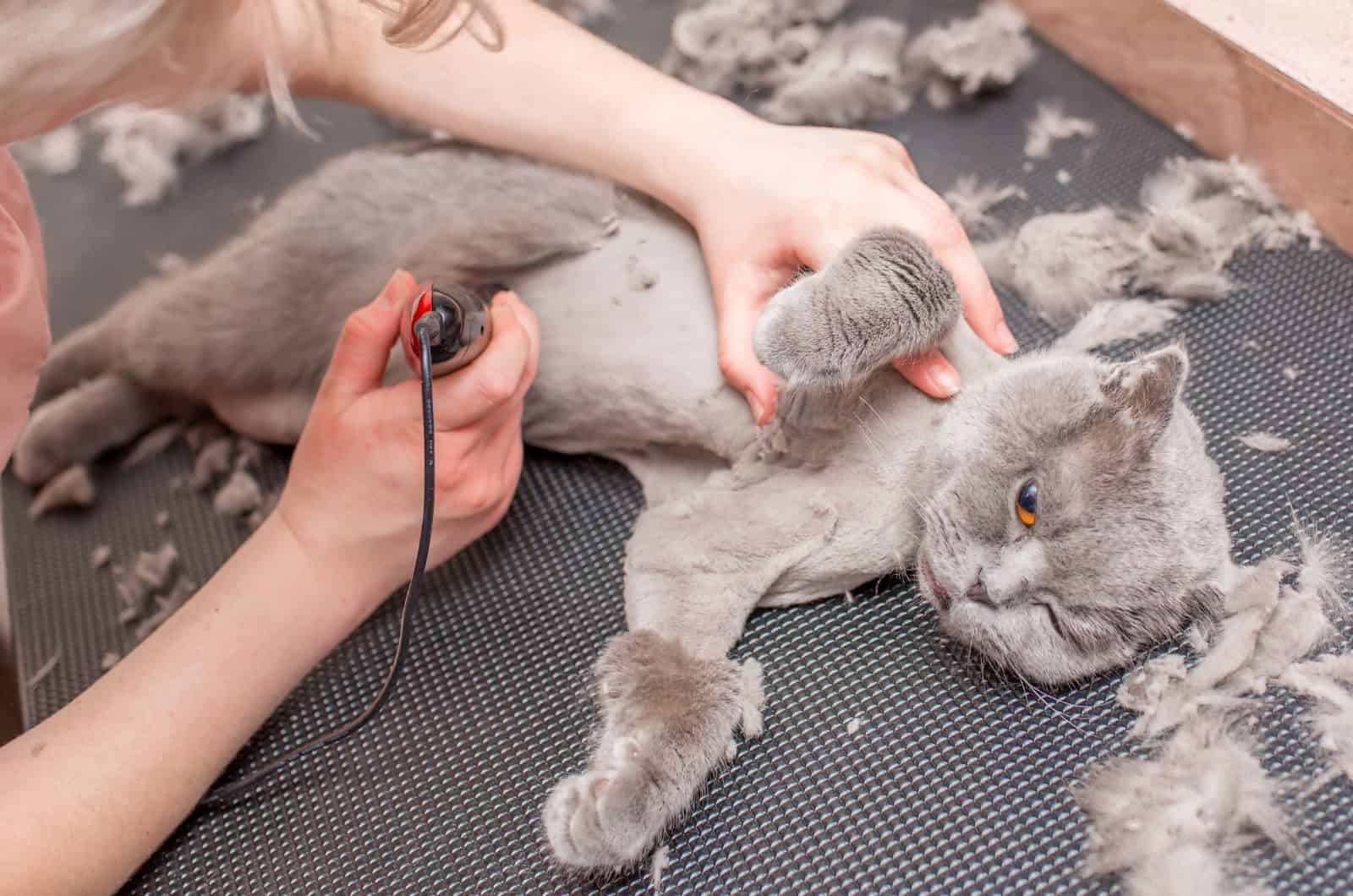
How Long Does It Take For Fur To Grow Back On A Cat?
How long will it take for a cat’s fur to grow back fully depends on whether the cat’s hair is short or long. As you might guess, it takes much longer for the fur of a long-haired cat (such as the Persian cat) to grow compared to the fur of a short-haired cat (such as the Abyssinian cat).
For long-haired cats, it may take between four and six months for the hair to get back to its full length. You should anticipate your cat’s hair regrowing in a matter of weeks to 3 months if they have short hair.
Is It Normal For Cats To Have Bald Spots?
Bald spots are not normal and are usually a symptom of an underlying disease or infection a cat is dealing with. The potential causes of a cat developing bald spots include flea or ringworm infestations, food allergies, abscesses, dermatitis, psychogenic alopecia, and other associated diseases.
Remember that a cat’s hair loss is a symptom, not a problem in and of itself. If your cat is starting to get bald patches, I highly suggest visiting the vet’s office for a thorough, professional examination.
What Are The Benefits Of Shaving A Cat?
It is not advised to shave a cat for aesthetic reasons, but there are several situations in which shaving a cat may be beneficial, depending on the circumstances:
• Cats are commonly shaved before surgery in order to provide easy access to the surgical site. This may also be done to allow for a clear site when applying a topical medicine.
• If the cat has very matted fur and the tangles cannot be untangled, shaving may be recommended.
• If a cat is prone to severe hairball issues, shaving is a good way to prevent hairball formation in the first place.
There is a common misconception that shaving a cat will make them cooler during summertime, but this is far from the truth! Shaving a cat does the exact opposite; it can actually lead to a cat developing serious sunburn!
Final Thoughts
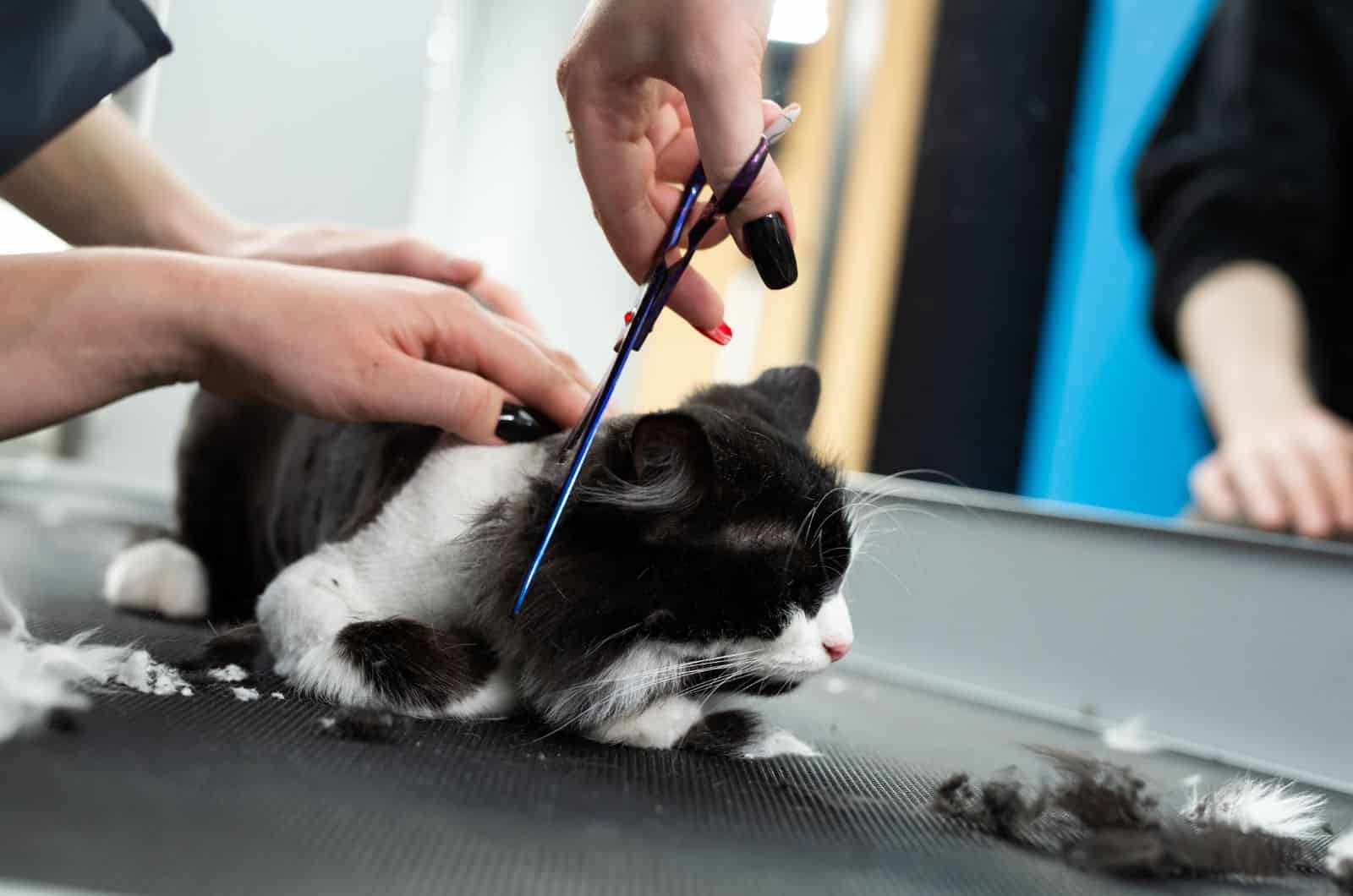
All cat owners want their cat’s fur to be healthy, shiny and… full length! However, some cats might experience hair loss, or their fur may have had to be shaved off.
Does cat hair grow back? This is a question that arises for every pet owner whose cat loses their hair. The answer to this question depends on what caused the hair loss; was the hair shaved off or did it fall out due to a medical issue? This will determine whether or not the hair grows back.
In the vast majority of cases, a cat’s hair will grow back. However, hair regrowth will not happen if the cause of hair loss is genetic or if the disease or infection causing the hair loss is not treated.
If a cat has simply been shaved, their fur typically begins to regrow within a few weeks. When it comes to cats suffering from a specific medical condition, the hair will not start growing back without proper treatment. In most cases, as soon as the health issue is resolved, the hair will start regrowing.
Long-haired cats may need to wait up to 6 months before their coat fully regrows, whereas short-haired cats will have their hair back in 2 months or less.
I hope this article has helped you and I’m sure your cat’s hair will be nice and fluffy in no time!
Related Articles:
Cats With Undercoats – Grooming And Care Tips

